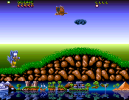Bit of Australian.Btw, which accent does he have?
It's amazing that 7+ years on from release, the Amiga was getting fabulous and pioneering games. The video is wrong about the name of 'chunky' pixels though. They were called chunky because the pixels occupied a single chunk of RAM - nothing to do with their 'chunky' appearance, and we use the same 'chunky' format now.
Edit: Grind looks an amazing achievement, another of these examples of making hardware do the impossible.


